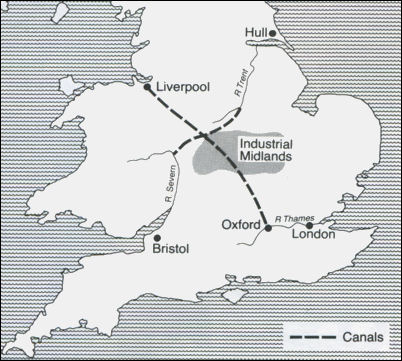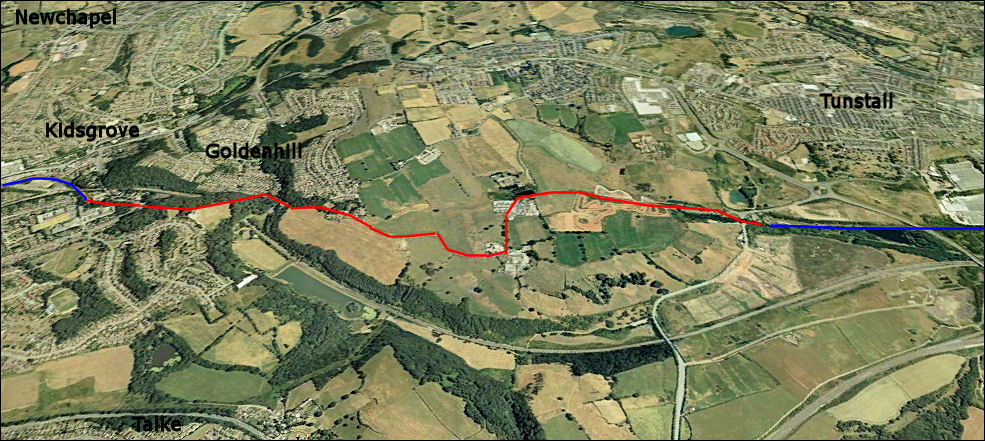|
The "Grand Cross"
of canals:
The map below shows how a waterway
from the east coast to the west coast of England would link up the
important ports of Hull and Liverpool.
James Brindley had a plan to join the Mersey to the Trent and the Thames to the
Severn. When these two systems were linked up, a 'Grand Cross' would
be formed, providing a canal system between London, Liverpool,
Bristol and Hull.

The 'Grand Cross' - a canal system between
London, Liverpool, Bristol and Hull.
The Runcorn extension to the Bridgewater Canal had been built
with the idea of joining it up to a future canal linking the Mersey
to the Trent.
Josiah Wedgwood, the wealthy factory owner, was willing to
provide money for the canal because he owned a pottery at Burslem,
Stoke-on-Trent and needed a way of getting Cornish china clay to his
works. A meeting was held in Staffordshire in December 1765:
"Mr Wedgwood and many other important
gentlemen were present to take part in the proceedings. Mr
Brindley was called upon to explain his plans. He did this so
clearly that it was clear to the dullest person present what he
meant.
It was decided that steps should be taken to apply for a bill in
the next session of Parliament. Mr Wedgwood put his name down for
£1000 and promised to buy a large number of shares.
The promoters of the plan proposed to call the project 'The Canal
from the Trent to the Mersey' but Brindley urged that it should be
called 'The Grand Trunk because other canals would branch out from
it at various points of its course."
An Act was passed giving permission for the building of a canal
on 3 May 1766. Samuel Smiles wrote:
"There
was great rejoicing at Burslem on the news arriving of the passing
of the Act. The first sod of the canal was cut by Josiah Wedgwood.
It was a great day for the Potteries as the event proved. In the
afternoon, a sheep was roasted whole in Burslem market place for
the good of the poorer class of potters.
Wedgwood was most impressed with the
advantages of the canal. He knew how much his trade had suffered
as a result of poor roads and rivers and how it might grow if a
canal joined Liverpool, Hull and Bristol. On the banks of the
canal he built the famous Etruria Pottery Works, the finest
factory of its kind. Near the factory he built a mansion for
himself and cottages for his workpeople."
Brindley had stated that the new canal would be finished by
December 1772. But the work was held up by problems in digging a
tunnel through Harecastle Hill, west of Stoke-on-Trent. When
Brindley revealed his plan to drive a tunnel through the hill, many
people thought he was mad. The tunnel was over 2.5 km long and it
took 11 years to build.
All the work had to be done by hand. The workers or 'navvies'
used pick-axes and shovels for digging, candles for lighting and
dynamite to break up the rocks.
|
The tunnel became famous as an
engineering marvel. One merchant wrote:
"Gentlemen! Come and look at the eighth wonder of the world,
the underground canal which is the work of the great Mr
Brindley. He handles rock as easily as you would handle plum
pies. He is as plain a looking man as one of the peasants
of the Peak or one of his own carters. But when he speaks,
all ears listen and every mind is filled with wonder at the
things he says are possible. He has cut a mile through bogs
which he binds up, embanking them with stones which he gets
from other parts of the canal.
On the side of Yelden Hill, he has a pump which is
worked by water and a stove which sucks through the damps
which would otherwise annoy the men who are cutting towards
the centre of the hill. He cuts the clay which he uses as
bricks to arch the subterraneous parts. We would like to see
the canal finish at Wilden Ferry when we shall be able to send
coal and pots to London and to different parts of the globe." |
Unfortunately Brindley never saw the tunnel or the canal
completed. He became ill from diabetes and died in 1772. His
brother-in-law, Hugh Henshall, carried on with the work and the
tunnel was finished in May 1777. There was no towpath through the
tunnel, so the bargees had to push the barges along by lying on
their backs and bracing their legs against the tunnel walls. This
was known as 'legging' and it was very tiring.
The Trent and Mersey Canal, and others which followed, brought
enormous benefits for industry. Thomas Bentley, a friend of Josiah
Wedgwood, wrote:
"The most obvious effect of the new canal is that it cuts
the cost of sending goods and opens up an easy way of getting from
the distant parts of the country to the sea. Not only does the
canal increase the number of factories but occasions the setting
up of many new ones in places where the land was of little value
and where there were few people. The means of sending goods by
water to the towns of Hull and Liverpool also helps the merchants,
by enabling them to export greater quantities of goods from those
parts which lie a long way from the sea."
How Brindley planned the Harecastle
tunnel
1 He drew a plan and cross-section of the hill and worked out
where the tunnel was going to run.
2 The navvies started digging from either end of the tunnel
towards the middle.
3 Several vertical ventilation shafts were sunk into the hill
along the line of the tunnel.
4 Men were lowered down the shafts and then started tunnelling
out from them towards the other shafts and both ends of the
tunnel.
5 When the tunnel was completed, the shafts were left to
provide the bargees (men who worked on the canal barges) with
ventilation.

|
![]()
![]()
![]()


![]()
![]()
![]()